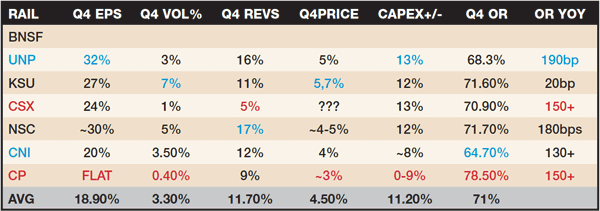Stay updated on news, articles and information for the rail industry
 railPrime
railPrime
February 2012
Rail News: Financials
Q4 2011: All in all, it's just another brick in the 'renaissance' wall
By Tony Hatch
One of the great takeaways from The Renaissance (15th century Italy, not the 1990s United States) was the invention (or reinvention) of perspective for its role in artistic development, as well as in a better understanding of the world. In the 21st century, especially in its second decade, the reinvention of a higher service product, with the management buy-in and informational and capital support behind it, has been the driver of the North American Railway Renaissance. But we must use that original gift of perspective to look at fourth-quarter 2011, a quarter at which the Street seemed to look with jaundiced eyes and see it for what it truly was: another solid brick in the new "renaissance" wall.
I love a little bit of controversy — in this case, as in whether the rail story is now over or that rail stocks are over-priced. And when you believe, as I do, that we are in the midst of a generational change in freight transportation, led by secular growth segments and (mostly) market share recapture, you can be accused of looking at data as it becomes available with the opposite viewpoint (the rosy one). But the long-term outlook/view does have the potential to make one want to sing "Everything's Coming Up Roses" — if the rails continue to execute. And so far, the improving operating metrics, near-term growth levels and capex budgets suggest that the renaissance is still young and the rather heavy-set lady opera singer has time to wait — and to gain perspective.
This year, the rail scorecard requires an understanding of inside baseball — indeed, after a usual scorecard of 80 percent or above winners (quarterly results above consensus) over the past decade, there was a lot of noise in this quarter and, in my opinion, picking of tiny nits that led to one day stock-price "corrections" that pulled some of the results back to "neutral," notably Norfolk Southern (NSC) and Kansas City Southern (KSU) ... the latter punished for foreign exchange market noise as much as anything.
The blue represents out-performance, either above the Street or within the group; the red obviously is the opposite. By that standard, Union Pacific (UNP) brings home the most gold medals followed by KSU; NSC won perhaps the most overall. As expected, Canadian Pacific (CP) brought up the rear in six of the seven categories.

Market opportunities/opportune markets — The rails are exploiting emerging market opportunities in intermodal, especially domestic; shale-related business; and autos/metals, grain and export coal. The industry is projecting another record capex year of $13 billion (up 8 percent or so), as I have been predicting since late last year, and railroads still are getting kudos for buybacks. They're also getting name-checked in publications like Barron's for the beginnings of a compelling yield story (notably NSC, CSX, UNP and CNI).
At the same time, the market continues to view the story as merely cyclical, despite lip service to the "renaissance." The day-trading results of NSC and KSU best reflect the current mood, which is "what have you done for me lately?" — actually, not a terrible sentiment for a investors who are meant to look forward and to use the recent past (i.e., Q4) only as a guide. For both NSC and KSU, I believe the clues are there to continue to support the future growth stories as we continue to muddle through recovery. First, they finished first (KSU) and second in volume growth; showed OK to good (NSC) operating performance and cost control; and have compelling growth stories emerging, supported by strangely still large (record, in fact) capital programs supporting opportunities such as Mexican, cross-border and corridor growth.
No help from above: no management calls for roaring economic growth — Railroads generally are supportive of a slow-but-steady growing economy, without much cyclical excitement save for autos/metals and the possible tiny comeback in housing. Their excitement, of course, is related to what they can control — the secular stories they either have helped to create (domestic intermodal, Mexican near-sourcing) or are happy to participate in (frac sand, rolling pipelines, etc.) or continue to participate in (ethanol).
There were some interesting splits in management’s 2012 outlook for various commodities, with UNP continuing to call international intermodal an issue (“slow/negative growth”) even after 2011 comparisons, and others coming in the low single-digit "positive" area (supported by TTX Co.'s own estimate). NSC projects decent growth, even after losing Maersk to CSX and with CSX locking up long-term business with Schneider. But given NS’s 2011 intermodal numbers, the Class I can afford to be expansive.
The National Retail Federation projects 4 percent import container growth this year; I will be at the Retail Industry Leaders Association's upcoming supply chain event — Logistics 2012, in Dallas (Feb. 19-22) — and will hear from more horses mouths while there. UNP also put "industrial chemicals" in the "moderate growth outlook" category, despite the capex by chemical producers excited by cheap and abundant feedstocks. Perhaps UP was simply being conservative. On price, everyone seems to continue to expect "above rail inflation," which I continue to think means north of 4 percent in the United States and 3 percent in Canada. Note: UNP has $1 billion or so of old legacy contracts to help it this year, and CSX didn’t show us its famous “same-store sales chart,” joining NSC in keeping mum — to which I say “Booo!”
Coal is the question, seeking an answer — Interestingly, eastern carriers CSX and NS expect what seems to be moderate-to-flat export coal growth, a thesis supported by a recent rail research trip I took to Australia; but they diverged greatly with respect to domestic coal, the former “steady eddie” bedrock of rail freight transportation. CSX sees continuing issues with fuel sourcing diversions toward natural gas, while NSC sees share loss as already having occurred; and with low current stockpiles, coal movements could return to normal (slow growth) with the help of weather; it's been unusually mild so far this winter.
Coal market share of utility fuel was over 50 percent as recently as 2000; by 2010, it was down to 45 percent. The courts have stayed recent regulatory efforts, but a big 2015 deadline on emissions looms — will share drop further this year or be stable for the next two or three years? How low can it go?
Working with known and noted Utilities Analyst Jay Dobson of Wunderlich Securities Inc., I hope to get a handle on this question, which for some reason doesn’t get a lot of play. The rails have been through wrenching change before — for example, the auto industry going from manufacturing 17 million cars here to assembling some 15 million here and there. And the same forces that are pressuring utilities to consider the coal-to-gas switch are helping to power highway-to-rail share shift as well as the frac sand, brine water, pipe and rolling pipeline movements out of North Dakota, Pennsylvania and so on. But even the frac business is roiling, with industry leader Chesapeake Energy cutting gas drilling just as Patriot Coal is cutting coal mining in efforts to reduce supply (good luck). Meanwhile, Hess Corp. is committed to opening its Tioga rail terminal next month, and going from some nine trainsets to 27 or so very soon.
Tony Hatch is an independent transportation analyst and consultant, a Progressive Railroading columnist and a program consultant for Progressive Railroading's RailTrends® conference. Email him at abh18@mindspring.com.


 2025 MOW Spending Report: Passenger-rail programs
2025 MOW Spending Report: Passenger-rail programs
 Gardner steps down as Amtrak CEO
Gardner steps down as Amtrak CEO
 Guest comment: Oliver Wyman’s David Hunt
Guest comment: Oliver Wyman’s David Hunt
 Women of Influence in Rail eBook
Women of Influence in Rail eBook





